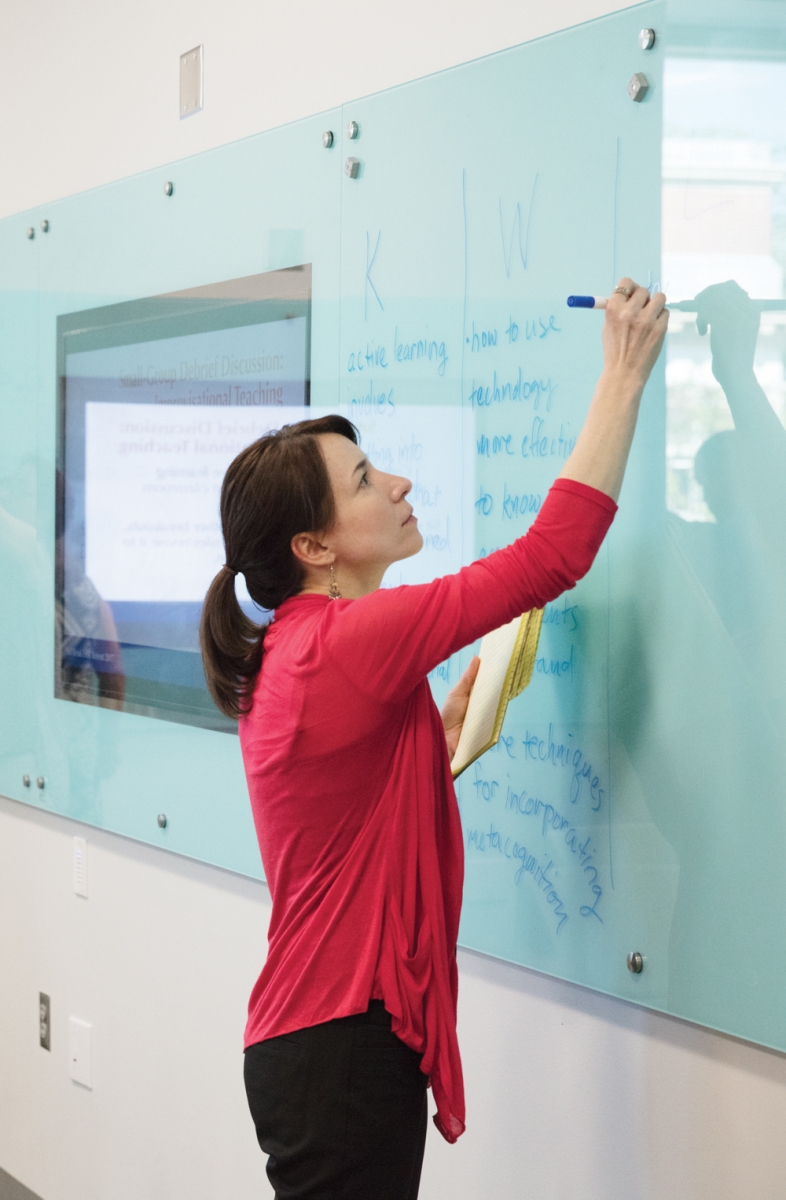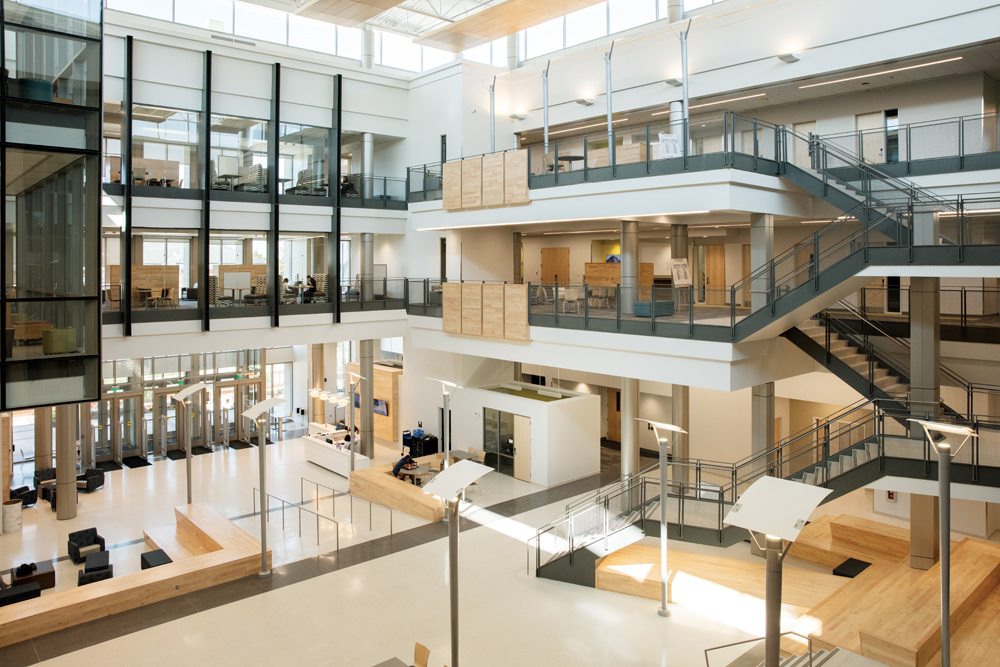Experiential learning is thought of largely as activities outside the classroom that better prepare students for work in the real world — things like internships, co-op programs, seminars, and community service and research projects.
But experiential learning’s scope is steadily expanding to include more activity inside the classroom, where professors teach by using methods other than traditional classroom lectures. The general idea is teaching students to solve problems as teams in a way that mimics the real world.
Auburn University, for example, invested $35 million in its new MELL Classroom Building, a 69, 000-square-foot facility that includes 26 classrooms equipped for ESAL, or engaged student active learning. The new facility’s classrooms are outfitted with technology that far exceeds laptops and projectors. Instead, students take an interactive approach by using multiple TV monitors, cameras and digital screens to collaborate and engage with peers and professors.
The idea is not to be fancy, though. It’s for professors to facilitate learning by having students solve problems in a real-world setting. “It’s a kind of hands-on learning that’s a subset of experiential learning, ” says Diane Boyd, director of Auburn’s Biggio Center for the Enhancement of Teaching and Learning.
Such learning is gaining traction because it has been proven effective in more ways than one. Studies have shown that students retain more of what they learn from active, or hands-on, learning compared with information they receive in classroom lectures.

|
What’s more, they learn more about how to learn and find answers, which is a skill set that will serve them well in the workplace. “In the experiential or an active learning class, the professor doesn’t cover material, ” Boyd says. “They uncover material.”
As an example, Boyd cites an introductory chemistry class led by an instructor and student learning assistants who’ve taken the course before.
“There are just maybe five to seven minutes of lecture, a very short lecture, ” Boyd says. “Then they work through the problems, and there is sort of a debrief where students reflect on how they tried to solve the problems and the professor is giving them feedback and tips for improving their performance in the future.
“From a business perspective, among the skills that employers say most students lack is the ability to receive feedback, the ability to self-assess and the ability to communicate to diverse audiences, ” Boyd says. “In that one example of an active classroom of learning in chemistry, students are building all of those skills that employers say graduates don’t have.
“They have to communicate with one another, with people who may not be like them either in the ways they think, or their backgrounds or even their majors. All of those skills employers say students lack are reinforced in the active learning environment.”
A major benefit of active learning is that it leaves students with a problem-solving skill set and experience that can be used in different environments in the years ahead, regardless of a student’s major, according to Boyd and others.
Bob Wood, dean of the Mitchell College of Business at the University of South Alabama, sees it that way, regardless of the kind of experiential learning.
“I tell parents and students that half the students starting school now will be working in industries within 10 years that don’t currently exist, ” Wood says. “The challenge is we’ve got students that will be working in industries that aren’t there right now, so what skill set do we give them?
“The more exposure we can give them to put those skill sets into practice, the better off they will be. I’ve got some very bright 4.0 kids here who want experiential learning on top of that, which is just adding to their credentials. Then you’ve got some students coming in who are good test takers, and they’re very bright intellectuals. But they come out of here and they can’t communicate, and they have no idea how the real world communicates. And all they’ve learned is theory. I do wonder how that would benefit an employer.”
Quoc Hoang, director of experiential learning at the University of Alabama’s Culverhouse College of Commerce, says that experiential learning is “messy” compared with traditional classroom lectures. But that’s a good thing, he says, because it’s more like the real world.
“Academic assignments are typically done in a controlled environment, with no real consequences other than your grade, ” Hoang says. “The real world is messy, because of incomplete information, politics, etc., but you still have to make decisions that have significant impact on your performance and career. Experiential learning previews the messiness in the real world, which allows students to gauge how it affects their ability to carry out work and be successful.
“Even if an educator does all the things we know lead to high-quality experiential learning, the experience still has the potential to be messy. Messy situations are uncomfortable. They require a lot of time and energy to figure out and, in some cases, students are intimidated by the potential that they won’t be able to figure out what they need to be successful. In my mind, though, why not get out of your comfort zone now, when you have supportive faculty, academic advisors, friends and fellow students around instead of once you are in the workforce with much less support?”

ABOVE Auburn University's new MELL Classroom Building
Despite its obvious benefits, not everyone buys into the concept of active learning, internships and the like. In short, it takes more time and effort than just going to class and taking notes. It is absolutely necessary for students in active learning classes, for example, to prepare ahead of time for problem-solving scenarios they will participate in during classes.
Many students today prefer communicating with their cell phones and simply aren’t thrilled by the prospect of interacting with others in a classroom project. And it isn’t just students resisting the change. Some faculty members prefer to stick with classroom lecturing.
“Students universally do not embrace this methodology (active learning), ” Boyd says. “Students who are used to performing with minimal effort — I’m talking about bright students, Auburn has many, many bright students — initially chafe at active learning, because it changes rules of the learning game, in effect. And that takes a lot of effort on the faculty’s part to communicate the value of active learning and help students see the more they practice solving problems they think are impossible and that they can’t solve, the better they will be at solving problems ad infinitum, the rest of their lives.”
All agree that experiential learning is growing in importance and acceptance. Says Jennifer English, associate dean of undergraduate education at the University of Alabama in Huntsville’s College of Engineering: “I don’t think it’s a matter of students being super serious. I just think it’s more a matter of what the market is looking for.”
UAH’s engineering students are generally involved in some form of experiential learning, whether it be internships, co-op programs or working for campus organizations. More than half of UAH’s engineering students have a “meaningful experiential learning experience” while in school, English says.
“Those students truly mature and develop in a way that a pure, on-campus college education just can’t provide for them, ” she says. “We just can’t train them that way. We provide them with the concepts and the skills and the book learning, but the skills they learn on the job or the skills working on teams within student organizations are just too valuable to think they are not really an important — I’m close to saying a required — component of a students’ education.”
Meanwhile, Wood says that last year’s incoming class will be required to have at least some experiential learning before graduating from USA’s business school. “I do know our president is committed to it, and I do know that over the next few years most students will have experience in that regard, ” he says.
“It’s doable. It’s just getting the mindset that, ‘Hey, we’re going to move forward with this, and it’s something that will benefit you.’ And I think when students realize the benefit from these opportunities, they will embrace them.”
Charlie Ingram and Cary Norton are freelance contributors to Business Alabama. Both are based in Birmingham.
TEXT BY CHARLIE INGRAM // PHOTOS BY Cary Norton



